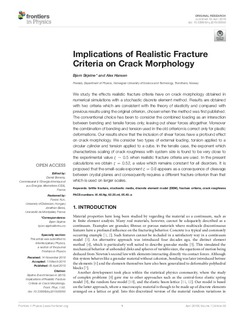| dc.contributor.author | Skjetne, Bjørn | |
| dc.contributor.author | Hansen, Alex | |
| dc.date.accessioned | 2019-09-26T08:12:59Z | |
| dc.date.available | 2019-09-26T08:12:59Z | |
| dc.date.created | 2019-06-13T16:40:48Z | |
| dc.date.issued | 2019 | |
| dc.identifier.citation | Frontiers in Physics. 2019, 7 . | nb_NO |
| dc.identifier.issn | 2296-424X | |
| dc.identifier.uri | http://hdl.handle.net/11250/2618887 | |
| dc.description.abstract | We study the effects realistic fracture criteria have on crack morphology obtained in numerical simulations with a stochastic discrete element method. Results are obtained with two criteria which are consistent with the theory of elasticity and compared with previous results using the original criterion, chosen when the method was first published. The conventional choice has been to consider the combined loading as an interaction between bending and tensile forces only, leaving out shear forces altogether. Moreover the combination of bending and tension used in the old criterion is correct only for plastic deformations. Our results show that the inclusion of shear forces have a profound effect on crack morphology. We consider two types of external loading, torsion applied to a circular cylinder and tension applied to a cube. In the tensile case, the exponent which characterizes scaling of crack roughness with system size is found to be very close to the experimental value ζ ~ 0.5 when realistic fracture criteria are used. In the present calculations we obtain ζ = 0.52, a value which remains constant for all disorders. It is proposed that the small-scale exponent ζ = 0.8 appears as a consequence of cleavage between crystal planes and consequently requires a different fracture criterion than that which is used on larger scales. | nb_NO |
| dc.language.iso | eng | nb_NO |
| dc.publisher | Frontiers Media | nb_NO |
| dc.rights | Navngivelse 4.0 Internasjonal | * |
| dc.rights.uri | http://creativecommons.org/licenses/by/4.0/deed.no | * |
| dc.title | Implications of Realistic Fracture Criteria on Crack Morphology | nb_NO |
| dc.type | Journal article | nb_NO |
| dc.type | Peer reviewed | nb_NO |
| dc.description.version | publishedVersion | nb_NO |
| dc.source.pagenumber | 25 | nb_NO |
| dc.source.volume | 7 | nb_NO |
| dc.source.journal | Frontiers in Physics | nb_NO |
| dc.identifier.doi | 10.3389/fphy.2019.00050 | |
| dc.identifier.cristin | 1704737 | |
| dc.description.localcode | © 2019 Skjetne and Hansen. This is an open-access article distributed under the terms of the Creative Commons Attribution License (CC BY). The use, distribution or reproduction in other forums is permitted, provided the original author(s) and the copyright owner(s) are credited and that the original publication in this journal is cited, in accordance with accepted academic practice. No use, distribution or reproduction is permitted which does not comply with these terms. | nb_NO |
| cristin.unitcode | 194,63,15,0 | |
| cristin.unitcode | 194,66,20,0 | |
| cristin.unitname | Institutt for matematiske fag | |
| cristin.unitname | Institutt for fysikk | |
| cristin.ispublished | true | |
| cristin.fulltext | original | |
| cristin.qualitycode | 1 | |

